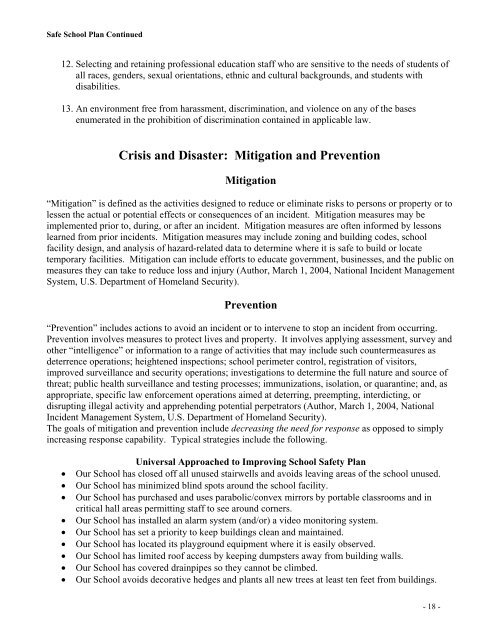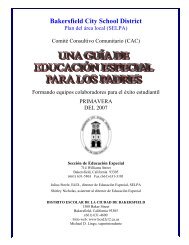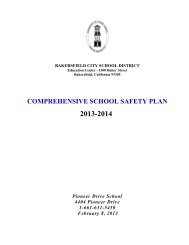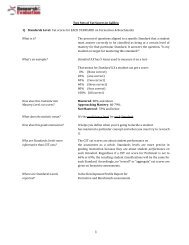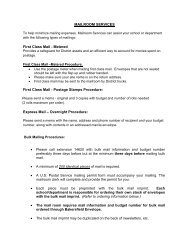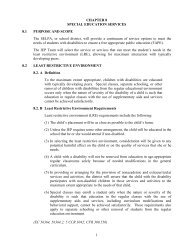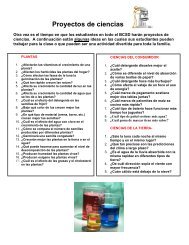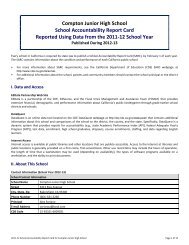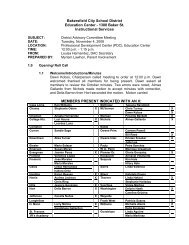EisslerSafetyPlan201.. - BCSD Static Server - Bakersfield City ...
EisslerSafetyPlan201.. - BCSD Static Server - Bakersfield City ...
EisslerSafetyPlan201.. - BCSD Static Server - Bakersfield City ...
Create successful ePaper yourself
Turn your PDF publications into a flip-book with our unique Google optimized e-Paper software.
Safe School Plan Continued<br />
12. Selecting and retaining professional education staff who are sensitive to the needs of students of<br />
all races, genders, sexual orientations, ethnic and cultural backgrounds, and students with<br />
disabilities.<br />
13. An environment free from harassment, discrimination, and violence on any of the bases<br />
enumerated in the prohibition of discrimination contained in applicable law.<br />
Crisis and Disaster: Mitigation and Prevention<br />
Mitigation<br />
“Mitigation” is defined as the activities designed to reduce or eliminate risks to persons or property or to<br />
lessen the actual or potential effects or consequences of an incident. Mitigation measures may be<br />
implemented prior to, during, or after an incident. Mitigation measures are often informed by lessons<br />
learned from prior incidents. Mitigation measures may include zoning and building codes, school<br />
facility design, and analysis of hazard-related data to determine where it is safe to build or locate<br />
temporary facilities. Mitigation can include efforts to educate government, businesses, and the public on<br />
measures they can take to reduce loss and injury (Author, March 1, 2004, National Incident Management<br />
System, U.S. Department of Homeland Security).<br />
Prevention<br />
“Prevention” includes actions to avoid an incident or to intervene to stop an incident from occurring.<br />
Prevention involves measures to protect lives and property. It involves applying assessment, survey and<br />
other “intelligence” or information to a range of activities that may include such countermeasures as<br />
deterrence operations; heightened inspections; school perimeter control, registration of visitors,<br />
improved surveillance and security operations; investigations to determine the full nature and source of<br />
threat; public health surveillance and testing processes; immunizations, isolation, or quarantine; and, as<br />
appropriate, specific law enforcement operations aimed at deterring, preempting, interdicting, or<br />
disrupting illegal activity and apprehending potential perpetrators (Author, March 1, 2004, National<br />
Incident Management System, U.S. Department of Homeland Security).<br />
The goals of mitigation and prevention include decreasing the need for response as opposed to simply<br />
increasing response capability. Typical strategies include the following.<br />
<br />
<br />
<br />
<br />
<br />
<br />
<br />
<br />
<br />
Universal Approached to Improving School Safety Plan<br />
Our School has closed off all unused stairwells and avoids leaving areas of the school unused.<br />
Our School has minimized blind spots around the school facility.<br />
Our School has purchased and uses parabolic/convex mirrors by portable classrooms and in<br />
critical hall areas permitting staff to see around corners.<br />
Our School has installed an alarm system (and/or) a video monitoring system.<br />
Our School has set a priority to keep buildings clean and maintained.<br />
Our School has located its playground equipment where it is easily observed.<br />
Our School has limited roof access by keeping dumpsters away from building walls.<br />
Our School has covered drainpipes so they cannot be climbed.<br />
Our School avoids decorative hedges and plants all new trees at least ten feet from buildings.<br />
- 18 -


